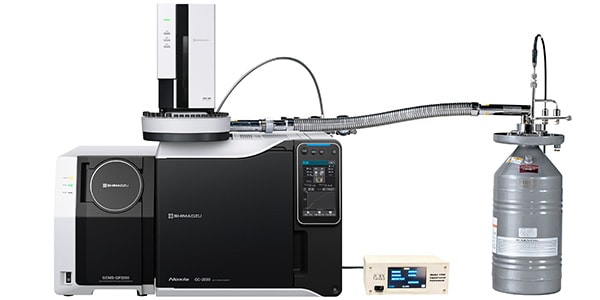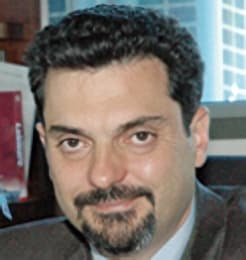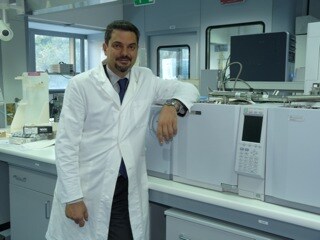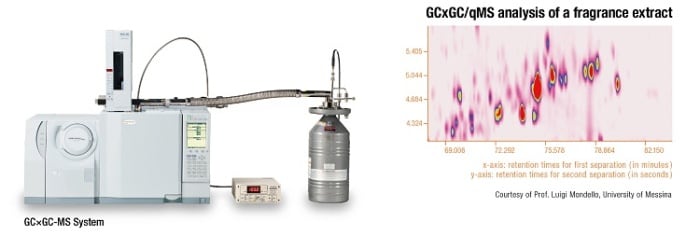
Comprehensive GCxGC System

INDUSTRY
Life Science, Small Molecule Pharmaceutical
KEYWORD
INTRODUCTION SERVICE&PRODUCTS
Comprehensive GCxGC System

*Affiliates and titles of the interviewee are current as of the time of reporting.
University of Messina
(1) More faster, more sensitive
Counterterrorism experts, pediatricians, perfumers, and professional sports watchdogs might seem, at first glance, to share few professional concerns. But many within these fields face a common challenge: the need to analyze complex biochemical substances.
For example, pediatricians, caring for infants that cannot tolerate milk need to figure exactly which protein is to blame and find substitutes. Counterterrorist experts struggle to pinpoint the origin of biological agents, which requires a precise knowledge of the subtle features that separate one bacterial strain from another. Sports regulators must monitor the growing number of natural and synthetic doping agents used by athletes to enhance their performance.
Scientists recruited to aid in these wide-ranging endeavors face the twin challenge of finding separation techniques that are fast enough to be of practical use and sensitive enough to provide conclusive and reliable results. The more technological progress is made, the greater scientists’ demands for even more sophisticated devices. They are often forced to do so by the increasing complexity of the subject matter. For example, the new range of designer steroids used by athletes is forcing a fundamental new approach to drug screening.
The latest progress in its chromatography devices—and particularly its comprehensive two-dimensional gas-gas chromatography (GC×GC) instruments—are set to change the way we think about and approach these problems and needs.
(2) Collaboration born in innovation, innovation born from collaboration
With more than 20 years of experience in the field, Professor Luigi Mondello has become a leading light in the field of separation techniques. Aside from his hundreds of articles, in 2002, he authored a book on separation techniques,Multidimensional Chromatography, which has come to define the field, and another entitledComprehensive Chromatography Combined with Mass Spectrometry, which will be printed in 2011. Thanks to his rich publication record, he received the "HTC-Award for the most outstanding and innovative work in the field of hyphenated chromatographic techniques" in 2006 and the "Silver Jubilee Medal for his Considerable Contribution to the Development of Separation Sciences" given by The Chromatographic Society in 2008.
Professor Mondello applies the instruments to the analysis of samples ranging from plant extracts, food products, petrochemicals, pharmaceutical and cosmetic products to various environmental substances.
"In particular, the development and introduction of multidimensional instrumentation, as well as innovative software, has contributed greatly toward revealing the unsuspected complexity of many real-world samples."
For example, Professor Mondello works with the petrol industry to separate fuels. Kerosene has frustratingly long analysis times. With the new chromatography devices, Professor Mondello has reduced processes that took two hours to two or three minutes. He has also worked with some of the world’s largest perfume designers to cut through the "forest of compounds" in their newest scents to find the allergens. Under the auspices of the North Atlantic Treaty Organization, his team created a 30-minute GC×GC-MS test to identify the bacteria present in a given sample by focusing on their unique fatty lipid profiles.
He now focuses on ultra-fast gas chromatography that allows users to perform analyses in greatly reduced times without losing information. Fast gas chromatography units are often linked with mass spectrometers for further analysis.
"This translates into the possibility of getting real time results. This is very useful when a high number of samples needs to be analyzed or immediate answers are needed."

Why did Professor Mondello choose Shimadzu?
Professor Mondello says he started working with Shimadzu because of the company’s willingness to completely rethink technology.
"In the last ten years Shimadzu has developed entirely new instrumentations. They did not just remake old instruments," he says, adding, "I also like the Japanese way of solving problems–slowly but with excellent results."
The working relationship developed into formal collaborations. Shimadzu provided instruments. Professor Mondello’s team developed software, modified the hardware, and sent back prototypes. Shimadzu then used those to make models for the market.
"We tested, advised and validated these powerful devices for speed and selectivity. It has been a very nice and fruitful collaboration."
Fast GC techniques have become routine over the past five to ten years
"When I first started my collaboration with Shimadzu, the use of fast GC and GC-MS was barely employed due to the lack of commercial instrumentation. Now, fast methods are routinely employed in many industrial and academic fields."
The same can be said for multidimensional chromatography methods. In fact, comprehensive two-dimensional gas-gas chromatography hardware and software have been developed and are now exploited by a great number of analysts across the world. GC×GC methods are making greater inroads in the analysis of fatty acid methyl esters in food and biological samples, of pesticides and petrochemicals, as well as flavours and fragrances.
"In short, analytical horizons have been extended," says professor Mondello.
(3) Further endeavor for development on fast chromatography instrumentation
Professor Mondello plans to continue developing instrumentation for fast GC, with attention focused on the injection system, and to develop more simple and effective modulators for comprehensive chromatography. He also plans to engage in the development of software for multidimensional chromatography and in MS spectra libraries, which will make compound identification a simpler and more reliable task.
"Our main common goal, namely the evolution of chromatography-mass spectrometry technology, will be achieved within the context of our intense collaboration with Shimadzu."
The upshot will be far reaching.
"Ten years from now, the comprehensive chromatography methods we are working with will have a revolutionary effect on the chromatography community. If we succeed in making these powerful technologies more accessible, both in hardware and software terms, then the impact will be a great one,"says professor Mondello.

The Comprehensive GC/MS (GCxGCMSq) technique employs a modulator to link two capillary columns of complementary orthogonal phases. The technique requires a GC-MS system capable of very fast data collection to fully capture the very narrow, fast eluting compounds. Sensitivity is also an important requirement for many Comprehensive GCxGC applications. The GCMS-QP2010 Ultra was developed with this multi-dimensional technique in mind. Its best-in-class data collection speeds and superior sensitivity make it the top choice for Comprehensive Chromatography.


The research group of the Analytical Food Chemistry Division of the University of Messina is composed of four full professors, one associate professor, two researchers, two main scientists of Chromaleont, post-docs, PhD and undergraduate students. The Food Chemistry section is supervised by Prof. Giovanni Dugo, while the Analytical Chemistry section is coordinated by Prof. Luigi Mondello. Prof. Luigi Mondello is also Technical Director of "Chromaleont S.r.l." in Italy, which is involved in offering solutions for the development of analytical instrumentation and dedicated software for the investigation of complex samples.